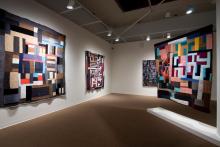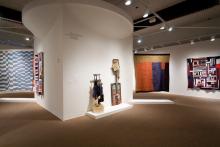Gee’s Bend is a small rural community nestled into a curve in the Alabama River southwest of Selma, Alabama. Founded in antebellum times, it was the site of cotton plantations, primarily the lands of Joseph Gee and his relative Mark Pettway, who bought the Gee estate in 1850. After the Civil War, the freed slaves took the name Pettway, became tenant farmers for the Pettway family, and founded an all-black community nearly isolated from the surrounding world.
Throughout much of the twentieth century, making quilts was considered a domestic responsibility for women in Gee’s Bend. As young girls, many of the women trained or apprenticed in their craft with their mothers, female relatives, or friends; other quilters, however, have been virtually self-taught. Women with large families often made dozens upon dozens of quilts over the course of their lives. The women consider the process of “piecing” the quilt “top” to be highly personal. In Gee’s Bend, the top—the side that faces up on the bed—is always pieced by a quilter working alone and reflects a singular artistic vision. The subsequent process of “quilting” the quilt—sewing together the completed top, the batting (stuffing), and the back—is sometimes then performed communally, among small groups of women.
The women of Gee’s Bend developed a distinctive, bold, and sophisticated quilting style based on traditional African-American quilts, but with a geometric simplicity reminiscent of Amish quilts and modern art. Art critics worldwide have compared this geometric simplicity to the works of important artists such as Henri Matisse and Paul Klee. The New York Times called the quilts “some of the most miraculous works of modern art America has produced.”
This exhibition puts the Gee’s Bend quilts in context by featuring the work of master quilt maker Mary Lee Bendolph and those she influenced, accompanied by the art of artists working in the found-object tradition who are part of her artistic sphere, including Thornton Dial and Lonnie Holley. Also shown is another interpretation of the quilt, in which Mary Lee and her daughter-in-law, Louisiana Bendolph, made a series of fine art prints based on their quilt designs in 2005. Finally, a documentary film about the women of Gee’s Bend accompanies the exhibition.
Other venues: Knoxville Museum of Art, July 10 – September 21, 2008
Loveland Museum & Gallery, CO, November 15, 2008 – February 8, 2009
Missouri Historical Society, April 12 – September 13, 2009
Berman Museum of World History, AL, October 2, 2009 – January 3, 2010
Flint Institute of Arts, MI, January 23 – April 18, 2010


